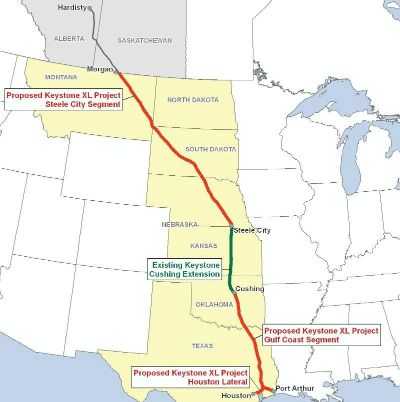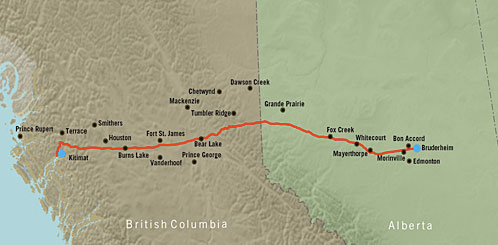Pipelines, Politics and Opportunity
When President Obama called Canadian Prime Minister Stephen Harper to tell him the U.S. had rejected TransCanada’s proposed $7 billion Keystone XL project, he made sure to point out that TransCanada was free to submit an amended plan for the pipeline.
Quick to make political hay out of the announcement, Mitt Romney said that the decision by Obama demonstrated a lack of seriousness about bringing down unemployment, restoring economic growth, and achieving energy independence. “He seems to have confused the national interest with his own interest in pleasing the environmentalists in his political base,” said the Republican Presidential hopeful.
Insiders and pundits have said, however, that the decision was made because the Republican led Congress had placed an arbitrary deadline on the decision to approve the pipeline which seemed calculated to force a green-lighting of the 1,661-mile (2,673- km) project. The plan backfired, and now the expensive process begins again.
While the blame can fly back and forth across the floor of the house of Congress and the borders between the U.S. and Canada, the bottom line is, Canada has oil that the U.S. wants and needs. The pipeline would send 700,000 barrels of crude a day from Alberta’s oil sands to refineries on the U.S. Gulf coast. It is estimated that 20,000 jobs would be created by the pipeline, many of which would be in the construction and servicing of valves.
Despite the fact that TransCanada has vowed to continue forging ahead with an application for the project with an amended route, Canada has made it very clear that it will seek other markets for its massive reserves, and another major pipeline that would ship Canadian oil sands crude to Asian markets is already in the planning stages.
Hearings have begun for another controversial pipeline, the Northern Gateway project in British Columbia. Calgary-based Enbridge Inc., hopes to lay a 728-mile (1,172-km) CAD 5.5 billion oil sands pipeline from Bruderheim outside Edmonton, AB, to the port town of Kitimat in British Columbia.
Northern Gateway would be comprised of dual pipelines. A 36-inch (94-cm) diameter line is planned to export approximately 525,000 barrels/day of oil sands crude to the planned Kitimat Marine Terminal, which will include two ship berths and 14 tanks for oil and condensate. The project includes a condensate line as well, which will be piped inland at the rate of 193,000 barrels/day through a 20-inch (51-cm) diameter line to Bruderheim.
The valve industry has much to gain from both of these projects. With block valve stations with remotely operated shutoff valves located approximately every 30 miles (45 km) on a pipeline and numerous valves in pumping stations and at the terminals, the financial benefits for valve manufacturers and supporting industries is enormous. Northern Gateway will have 10 pump stations and plans include installing safety control valves on either side of major water crossings. Keystone XL would include construction of eight pump stations in Canada and 30 pump stations in the United States.
While these pipelines have been met with political controversy and environmental protests, another major project, Enterprise Products LP’s 1,230-mile (1949-km) Appalachia-to-Texas pipeline (“ATEX Express”) is quietly moving forward with little fanfare. The project will deliver growing ethane production from the Marcellus/Utica Shale areas of Pennsylvania, West Virginia and Ohio to the U.S. Gulf Coast. The first leg of the system would involve construction of approximately 595 miles (958 km) of new pipeline extending from Washington County, PA, to Cape Girardeau, MO, closely paralleling an existing Enterprise pipeline.
At Cape Girardeau, Enterprise will reverse a 16-inch (40.6 cm) diameter pipeline and place it into ethane service. At the southern terminus of the pipeline, Enterprise will be constructing a 55-mile (89-km), 16-inch (41-cm) diameter pipeline to provide shippers with access to the partnership’s natural gas liquids storage complex at Mont Belvieu, TX. While company representatives are working with residents, landowners and community leaders along the proposed pipeline route, the project has been proceeding with no perceivable objections.
Whether controversial or not, pipelines mean big business for everyone in and supporting the valve industry. The challenge is to be ready when the opportunities arise.
Kate Kunkel, Valve Magazine’s new senior editor, has written extensively about industrial valves and the industries they serve. Kate will also be contributing to the Valve Magazine blog, writing Web-only articles and contributing to VMA’s social media platforms. Reach her at kkunkel@vma.org.
RELATED CONTENT
-
Valves in Space
All of these valves need to be built to precise fits and finishes and to stringent performance requirements because “On a spacecraft, everything has got to work. If it breaks, you’re done.”
-
The Pulp and Paper Industry
The pulp & paper industry has seen tough times, but the business will still be around for many decades; the product is too much in demand.
-
The Basics of Eccentric Plug Valves
Wastewater systems present many challenges to pumps and valves because the flow can contain grit, solids and debris, depending where in the process the equipment is located.













 Unloading large gate valve.jpg;maxWidth=214)